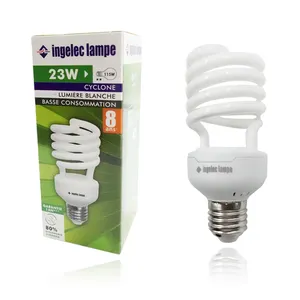
CE ROHS UL Listed 360 Degree Corn Led Light CFL Replacement G24d 2pin Base LED Bulb 3CCT Selectable 12W Corn LED G24 PL

















Compact fluorescent lamps (CFLs), commonly known as CFL bulbs, are a type of energy-saving light that serves as an alternative to traditional incandescent bulbs. These bulbs utilize a small amount of mercury vapor and phosphor to produce light, making them more energy-efficient and longer-lasting than their incandescent counterparts.
The variety of CFL bulbs is vast, with options ranging from the tubular design, the iconic spiral shape, to the more recent CFL LED hybrids. The bases of these bulbs are standardized, with common types being e27, b22, and e14, ensuring compatibility with existing light fixtures. Additionally, compact fluorescent bulbs come in a spectrum of colors, from warm whites to cool blues, catering to different lighting needs and preferences.
CFL lamps are versatile in their applications, suitable for both residential and commercial settings. They are often used in desk lamps, ceiling fixtures, and outdoor lighting solutions. Specialty CFLs, such as the g24q 1 base type, are designed for specific lighting fixtures, while spiral bulbs are a popular choice for their aesthetic appeal and efficient light distribution.
The primary advantage of compact fluorescent light bulbs is their energy efficiency. They consume approximately 70% less energy than incandescent bulbs, which can lead to significant savings on electricity bills. Moreover, with a longer lifespan, the need for frequent replacements is reduced, making them an eco-friendly lighting solution. The variety within the category, such as the 13 watt CFL bulb or the 3 CFL configuration, offers consumers options to match the intensity and design to their specific needs.
Compact fluorescent technology has evolved to reduce its environmental impact. The materials used in CFL tube light production are chosen for durability and efficiency. While CFLs do contain mercury, advancements in the technology have led to a reduction in the amount used, and recycling programs have become more accessible to handle spent bulbs responsibly.
When selecting CFL light bulbs, it is important to consider the lumens (brightness), the color temperature (measured in Kelvin), and the energy consumption (watts). For instance, a 13w CFL is an excellent choice for those seeking a balance between brightness and energy use. Consumers should also be aware of the size and shape of the bulb to ensure it fits their fixtures and provides the desired aesthetic.